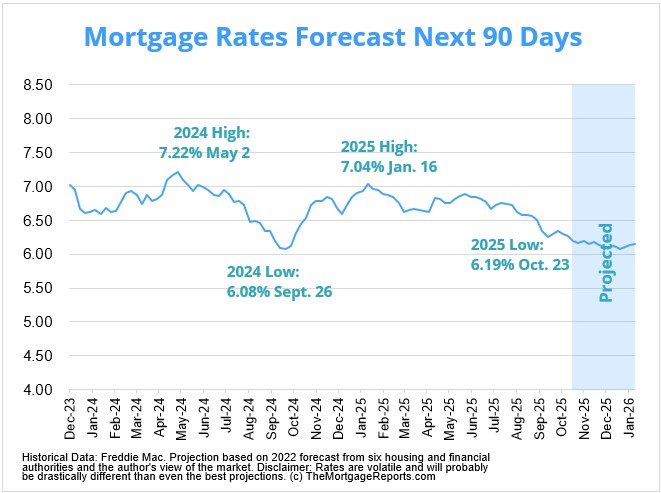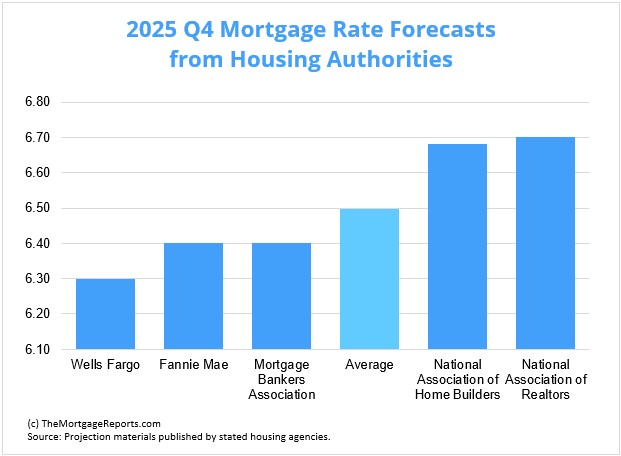Mortgage rate forecast for next week (Oct. 27-31)
Mortgage rates decreased for the third consecutive week and dropped to a 13-month low.
The average 30-year fixed rate mortgage (FRM) fell to 6.19% on Oct. 23 from 6.27% on Oct. 16, according to Freddie Mac. The last time the average 30-year FRM went above 7% was Jan. 16, 2025.
“Mortgage rates continued to trend down this week, hitting their lowest level in over a year,” said Sam Khater, chief economist at Freddie Mac. “At the start of 2025, the 30-year fixed-rate mortgage surpassed 7%, while today it hovers nearly a full percentage point lower. This dynamic has kept refinancings high, accounting for more than half of all mortgage activity for the sixth consecutive week.”
Rates have mostly moved within a fairly narrow band as the government shutdown casts shadows of uncertainty, withholds data, and halts programs for home buyers.
| Average 30-year fixed rate | 1-week ago | 4-weeks ago | 3-months ago | 1-year ago |
| 6.19% | 6.27% | 6.30% | 6.74% | 6.54% |
The latest borrowing activity
Though lagging, the most recent weekly mortgage application report from the Mortgage Bankers Association showed a seasonally adjusted 0.3% decrease for the seven days ending Oct. 17. The refinance index rose 4% and the purchase index declined 5% week-over-week.
“The lowest mortgage rates in a month spurred an increase in refinance activity, including another pickup in ARM applications. The refinance index increased 4%, driven by a 6% increase in conventional refinances and a 12% increase in FHA refinance applications, as borrowers remain attentive to these opportunities to lower their monthly mortgage payment,” said Joel Kan, deputy chief economist at the MBA.”
“ARM applications increased 16% over the week, with the ARM rate more than 80 basis points lower than the 30-year fixed rate. Purchase applications were down over the week but remained 20% higher than a year ago.”
Find your lowest mortgage rate. Start hereIn this article (Skip to...)
- Will rates go down in October?
- 90-day forecast
- Expert rate predictions
- Mortgage rate trends
- Rates by loan type
- Mortgage strategies for October
- Mortgage rates FAQ
Will mortgage rates go down in October?
“I expect mortgage rates to ease modestly into year-end, but I wouldn’t frame this as a straight-line story.”
-Tony Julianelle, CEO at Atlas Real Estate
Mortgage rates fluctuated significantly in 2023, with the average 30-year fixed rate going as low as 6.09% and as high as 7.79%, according to Freddie Mac. That range narrowed in 2024, spreading from 6.08% to 7.22%, and narrowed further in 2025 between 6.26% and 7.04%.
Find your lowest mortgage rate. Start hereWith the economy probably heading into a recession, we may have already seen the peak of this rate cycle. But if inflation rises, mortgage rates could uptrend. Of course, interest rates are driven by many factors and notoriously volatile, so they could change direction any given week.
Experts from Cornerstone Capital, First American, and others weigh in on whether 30-year mortgage rates will climb, fall, or level off in October.
Expert mortgage rate predictions for October

Dan Cooper, EVP of capital markets and servicing at Cornerstone Capital Bank
Prediction: Rates will decrease
“Several factors will likely result in a stable to modest downward drift in interest rates during October, including fear that tariffs will continue to push inflation higher combined with concerns over a weakening economy. Right now, we’re seeing slowing business activity, falling factory orders, weaker consumer spending, softer hiring, and a sharp drop in housing starts and permits. These factors, along with the high probability of another 25 basis point Fed rate cut at the end of October, should result in stable interest rates overall, with a slight bias toward mortgage rates drifting lower throughout the month.”

Ralph DiBugnara, president at Home Qualified
Prediction: Rates will moderate
“September brought us the lowest average rates we have seen in 2025. That was a result of the anticipated cut by the Fed. I believe that the Fed could cut in the future, but it may not be at the next meeting. With that being the case, I do believe we have found a new average rate that the market is comfortable with, based on what’s going on in the economy. Unemployment is higher, inflation is creeping up, and the real estate market has gotten busier with buyers.”

Charles Goodwin, head of bridge and DSCR lending at Kiavi
Prediction: Rates will moderate
“The 10-year Treasury yield has trended down throughout summer and into September. However, in the days following the recent cut, the 10-year Treasury yield—which is tied to mortgage rates—has increased. This also occurred after the September 2024 rate cuts, and bond investors are clearly still concerned about long-term inflation prospects.
“Inflation and jobs data remain wild cards, as persistent inflation could keep pressure on yields, while weaker employment reports could create more room for rates to move down eventually. Overall, the lending environment is shaping up to be slightly more favorable for borrowers, even if a dramatic rate cut isn’t in the cards any time soon. My advice for borrowers is not to wait for that mythical perfect rate — if the numbers work and you have a solid purchase in mind, it’s a good time to act.”

Danielle Hale, chief economist at Realtor.com
Prediction: Rates will moderate
“Mortgage rates in October are likely to continue to be in a data-driven tug-of-war. I expect this to net out to slightly lower mortgage rates on average in October versus September, and stay within the 6.25%-to-6.5% range we saw. As we approached the Fed meeting, mortgage rates eased as expectations of a Fed rate cut rose, mirroring trends in longer term bond yields.
“Following the Fed’s rate cut, longer-term rates have edged higher, as projections from Fed participants are divided about the likely course of monetary policy, and the central tendency of Fed projections implies a somewhat higher policy rate than investors have priced in. This gap between Fed and investor expectations has created some near-term upward pressure on interest rates, including mortgage rates. Of course, incoming data will shape investor perceptions and the ultimate policy course. To the extent that inflation or economic growth and labor market data are higher than expected, I anticipate mortgage rates to trend to the upper side of the range. If inflation is lower or economic growth and labor market data weaker than anticipated, then we’ll see mortgage rates on the lower end of the range.”

Tony Julianelle, CEO at Atlas Real Estate
Prediction: Rates will decrease
“I expect mortgage rates to ease modestly into year-end, but I wouldn’t frame this as a straight-line story. I’m cautiously optimistic we’ll see a mild reprieve, but it’s fragile. Think of it as a tug-of-war: softening labor markets and a dovish Fed pulling one way, while inflation, tariffs, and fiscal pressures tug the other. My base case is modest relief - a 20–40 basis-point decline - but I’d put meaningful odds on rates bouncing higher again if inflation proves sticky. For now, borrowers may get a little breathing room, but no one should bank on it.”

Matt Pettit, president at Mountain West Financial
Prediction: Rates will decrease
“The Federal Reserve is reducing rates to send a message that mortgage lending needs to become more affordable. Home prices remain elevated, and reducing the monthly cost of owning a home would help more families purchase properties. However, this is only a small portion of the market correction necessary to open up home sales, especially for starter homes. The addition of down payment assistance programs, as well as other incentives, must be increased to right the housing ship.”

Rick Sharga, president and CEO at CJ Patrick Company
Prediction: Rates will moderate
“Mortgage rates have ticked up slightly since September’s long-anticipated Fed Funds rate cut, and are likely to remain in a narrow range between 6.25-6.5% for a 30-year, fixed-rate loan through October as the market awaits further guidance from the FOMC meeting at the end of the month. Further slowing in the U.S. economy and a weakening jobs market could force the Fed’s hand to cut further and faster, which would likely lead to lower mortgage rates as we approach the end of the year.”

Sam Williamson, senior economist at First American
Prediction: Rates will decrease
“Heading into October, borrowers can expect mortgage rates in the mid-to-low 6% range—a modest decline from the 6.5% averages seen in early September. Home buyers and borrowers can thank the notable shift in the Federal Reserve’s tone for the recent dip in rates, with policymakers acknowledging rising risks to the labor market, which has pushed down 10-year Treasury yields that mortgage rates loosely follow. Financial markets are already pricing in three rate cuts by year-end, suggesting limited room for further declines unless incoming data shows sharper labor market deterioration or a more pronounced slowdown in inflation. For now, the easing offers a welcome—if modest—improvement in affordability.”
Mortgage interest rates forecast next 90 days
As inflation ran rampant in 2022, the Federal Reserve took action to bring it down and that led to the average 30-year fixed-rate mortgage spiking in 2023.
With inflation gradually cooling, the Fed made three rate cuts in 2024 (September, November, and December). As uncertainty reigned in 2025, the central bank held the federal funds rate range steady for its first five meetings. Once the job market showed continued weakening, the Federal Reserve Open Market Committee decided it was enough to make a cut in September and signs point to another cut for October.
Find your lowest mortgage rate. Start hereOf course, rates could rise or fall on any given week due to many factors or if another global event causes widespread uncertainty in the economy.

Mortgage rate predictions for 2025
The 30-year fixed-rate mortgage averaged 6.19% as of Oct. 23, according to Freddie Mac. All five major housing authorities we looked at predict 2025’s fourth quarter average to finish above that.
Wells Fargo sits at the low end of the group, projecting the average 30-year fixed interest rate to settle at 6.3% for Q4. Meanwhile, the National Association of Realtors had the highest forecast of 6.7%.
| Housing Authority | 30-Year Mortgage Rate Forecast (Q4 2025) |
| Wells Fargo | 6.30% |
| Fannie Mae | 6.40% |
| Mortgage Bankers Association | 6.40% |
| National Association of Home Builders | 6.68% |
| National Association of Realtors | 6.70% |
| Average Prediction | 6.496% |

Current mortgage interest rate trends
Mortgage rates declined for the third straight week, reaching their lowest level in 13 months.
The average 30-year fixed rate decreased to 6.19% on Oct. 23 from 6.27% on Oct. 16. The average 15-year fixed mortgage rate similarly declined to 5.44% from 5.52%.
| Month | Average 30-Year Fixed Rate |
| October 2024 | 6.43% |
| November 2024 | 6.81% |
| December 2024 | 6.72% |
| January 2025 | 6.96% |
| February 2025 | 6.84% |
| March 2025 | 6.65% |
| April 2025 | 6.73% |
| May 2025 | 6.82% |
| June 2025 | 6.82% |
| July 2025 | 6.72% |
| August 2025 | 6.59% |
| September 2025 | 6.35% |
| October 2025 | 6.28% |
Source: Freddie Mac
After hitting record-low territory in 2020 and 2021, mortgage rates climbed to a 23-year high in 2023 before descending somewhat in 2024. Many experts and industry authorities believe they will follow a downward trajectory into 2025. Whatever happens, interest rates are still below historical averages.
Dating back to April 1971, the fixed 30-year interest rate averaged around 7.8%, according to Freddie Mac. So if you haven’t locked a rate yet, don’t lose too much sleep over it. You can still get a good deal, historically speaking — especially if you’re a borrower with strong credit.
Just make sure you shop around to find the best lender and lowest rate for your unique situation.
Mortgage rate trends by loan type
Many mortgage shoppers don’t realize there are different types of rates in today’s mortgage market. But this knowledge can help home buyers and refinancing households find the best value for their situation.
Find your lowest mortgage rate. Start hereWhich mortgage loan is best?
The best mortgage for you depends on your financial situation and your goals.
For instance, if you want to buy a high-priced home and you have great credit, a jumbo loan is your best bet. Jumbo mortgages allow loan amounts above conforming loan limits, which max out at $ in most parts of the U.S.
On the other hand, if you’re a veteran or service member, a VA loan is almost always the right choice. VA loans are backed by the U.S. Department of Veterans Affairs. They provide ultra-low rates and never charge private mortgage insurance (PMI). But you need an eligible service history to qualify.
Conforming loans and FHA loans (those backed by the Federal Housing Administration) are great low-down-payment options.
Conforming loans allow as little as 3% down with FICO scores starting at 620. FHA loans are even more lenient about credit; home buyers can often qualify with a score of 580 or higher, and a less-than-perfect credit history might not disqualify you.
Finally, consider a USDA loan if you want to buy or refinance real estate in a rural area. USDA loans have below-market rates — similar to VA — and reduced mortgage insurance costs. The catch? You need to live in a ‘rural’ area and have moderate or low income to be USDA-eligible.
Mortgage rate strategies for October 2025
Mortgage rates displayed their famous volatility throughout 2024 before falling into a gradual decline through 2025. The Fed’s September rate cut and growing potential for another in October and more in 2026 provide optimism for descending rates.
Find your lowest mortgage rate. Start hereHowever, the Trump Administration’s wealth consolidation and upturning inflation caused the Fed to pause in January, March, May, June, and July. As always, the committee said it would adjust its policies as necessary — which could mean additional cuts, none at all or even potential raises.
Here are just a few strategies to keep in mind if you’re mortgage shopping in the coming months.
Be ready to move quickly
Indecision can lead to failure or missed opportunities. That holds true in home buying as well.
Although the housing market is becoming more balanced than the recent past, it still favors sellers. Prospective borrowers should take the lessons learned from the last few years and apply them now even though conditions are less extreme.
“Taking too long to decide to make an offer can lead to paying more for the home at best and at worst to losing out on it entirely. Buyers should get pre-approved (not pre-qualified) for their mortgage, so that the seller has some certainty about the deal closing. And be ready to close quickly — a long escrow period will put you at a disadvantage.
“And it’s definitely not a bad idea to work with a real estate agent who has access to “coming soon” properties, which can give a buyer a little bit of a head start competing for the limited number of homes available,” said Rick Sharga.
If mortgage rates continue on a downward trajectory, more and more buyers will likely enter the market after being priced out on the sidelines. Being decisive (and prepared) should only play to your advantage.
Shopping around isn’t only for the holidays
Since interest rates can vary drastically from day to day and from lender to lender, failing to shop around likely leads to money lost.
Lenders charge different rates for different levels of credit scores. And while there are ways to negotiate a lower mortgage rate, the easiest is to get multiple quotes from multiple lenders and leverage them against each other.
“For potential home buyers, it’s important to get quotes from multiple lenders for a mortgage, as rates can vary dramatically, especially during such a volatile period,” said Odeta Kushi.
As the mortgage market slows due to lessened demand, lenders will be more eager for business. While missing out on the rock-bottom rates of 2020 and 2021 may sting, there’s always a way to use the market to your advantage.
How to shop for interest rates
Rate shopping doesn’t just mean looking at the lowest rates advertised online because those aren’t available to everyone. Typically, those are offered to borrowers with great credit who can put a down payment of 20% or more.
The rate lenders actually offer depends on:
- Your credit score and credit history
- Your personal finances
- Your down payment (if buying a home)
- Your home equity (if refinancing)
- Your loan-to-value ratio (LTV)
- Your debt-to-income ratio (DTI)
To figure out what rate a lender can offer you based on those factors, you have to fill out a loan application. Lenders will check your credit and verify your income and debts, then give you a ‘real’ rate quote based on your financial situation.
You should get three to five of these quotes at a minimum, then compare them to find the best offer. Look for the lowest rate, but also pay attention to your annual percentage rate (APR), estimated closing costs, and ‘discount points’ — extra fees charged upfront to lower your rate.
This might sound like a lot of work. But you can shop for mortgage rates in under a day if you put your mind to it. And shaving just a few basis points off your rate can save you thousands.
Compare mortgage and refinance rates. Start here
Mortgage interest rate FAQ
Current mortgage rates are averaging 6.19% for a 30-year fixed-rate loan and 5.44% for a 15-year fixed-rate loan, according to Freddie Mac’s latest weekly rate survey. Your individual rate could be higher or lower than the average depending on your credit score, down payment, and the lender you choose to work with, among other factors.
Mortgage rates could decrease next week (Oct. 27-31, 2025) if the mortgage market takes a cautious approach to a possible recession. However, rates could rise if lenders account for the Federal Reserve taking measures to counteract inflation or if a global event brings economic uncertainty.
If inflation continues to dissipate and the economy cools or goes into a recession, it’s likely mortgage rates will decrease in 2025. Although, it’s important to remember that interest rates are notoriously volatile and are driven by many factors, so they can rise during any given week.
Mortgage rates may rise in 2025. High inflation, strong demand in the housing market, and policy changes by the Federal Reserve in 2022 and 2023 all pushed rates higher. However, if the U.S. does indeed enter a recession, mortgage rates could come down.
Freddie Mac is now citing average 30-year rates in the 7% range. If you can find a rate in the 5s or 6s, you’re in a very good position. Remember that rates vary a lot by borrower. Those with perfect credit and large down payments may get below-average interest rates, while poor-credit borrowers and those with non-QM loans could see much higher rates. You’ll need to get pre-approved for a mortgage to know your exact rate.
For the most part, industry experts do not expect the housing market to crash in 2025. Yes, home prices are over-inflated. But many of the risk factors that led to the 2008 crash are not present in today’s market. Low inventory and massive buyer demand should keep the market propped up. Plus, mortgage lending practices are much safer than they used to be. That means there’s not a subprime mortgage crisis waiting in the wings.
At the time of this writing, the lowest 30-year mortgage rate ever was 2.65%. That’s according to Freddie Mac’s Primary Mortgage Market Survey, the most widely used benchmark for current mortgage interest rates.
Locking your rate is a personal decision. You should do what’s right for your situation rather than trying to time the market. If you’re buying a home, the right time to lock a rate is after you’ve secured a purchase agreement and shopped for your best mortgage deal. If you’re refinancing, you should make sure you compare offers from at least three to five lenders before locking a rate. That said, rates are rising. So the sooner you can lock in today’s market, the better.
That depends on your situation. It’s a good time to refinance if your current mortgage rate is above market rates and you could lower your monthly mortgage payment. It might also be good to refinance if you can switch from an adjustable-rate mortgage to a low fixed-rate mortgage; refinance to get rid of FHA mortgage insurance; or switch to a short-term 10- or 15-year mortgage to pay off your loan early.
It’s often worth refinancing for 1 percentage point, as this can yield significant savings on your mortgage payments and total interest payments. Just make sure your refinance savings justify your closing costs. You can use a mortgage calculator or speak with a loan officer to crunch the numbers.
Start by choosing a list of three to five mortgage lenders that you’re interested in. Look for lenders with low advertised rates, great customer service scores, and recommendations from friends, family, or a real estate agent. Then get pre-approved by those lenders to see what rates and fees they can offer you. Compare your offers (Loan Estimates) to find the best overall deal for the loan type you want.
What are today’s mortgage rates?
Mortgage rates are rising, but borrowers can almost always find a better deal by shopping around. Connect with a mortgage lender to find out exactly what rate you qualify for.
Time to make a move? Let us find the right mortgage for you1Today's mortgage rates are based on a daily survey of select lending partners of The Mortgage Reports. Interest rates shown here assume a credit score of 740. See our full loan assumptions here.
Selected sources:
- https://www.federalreserve.gov/monetarypolicy/fomccalendars.htm
- http://www.freddiemac.com/research/datasets/refinance-stats/index.page
